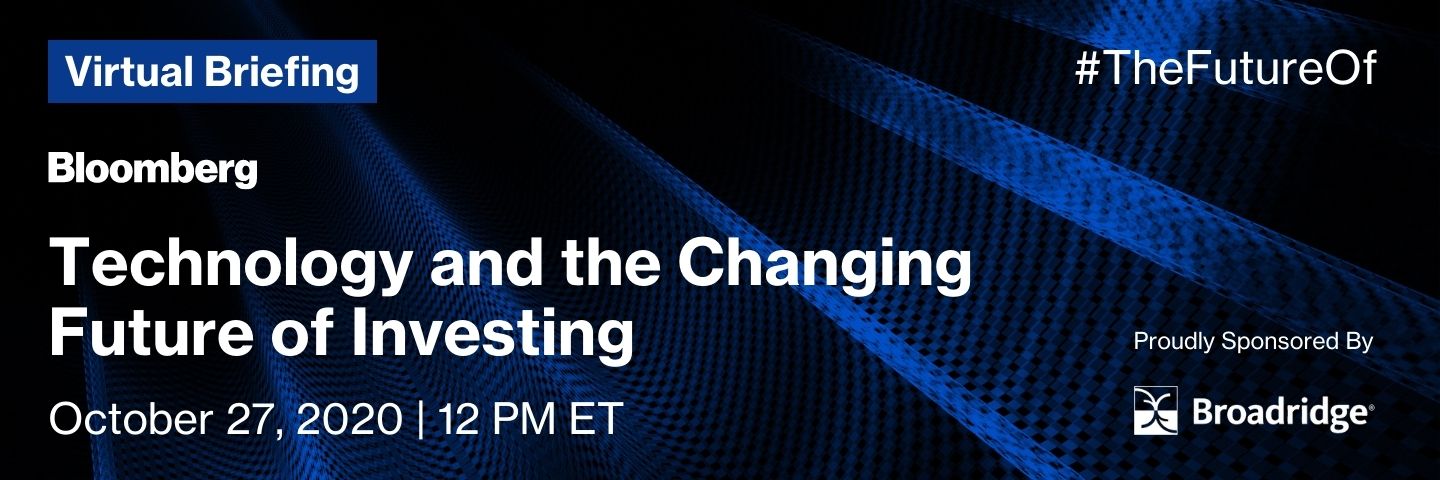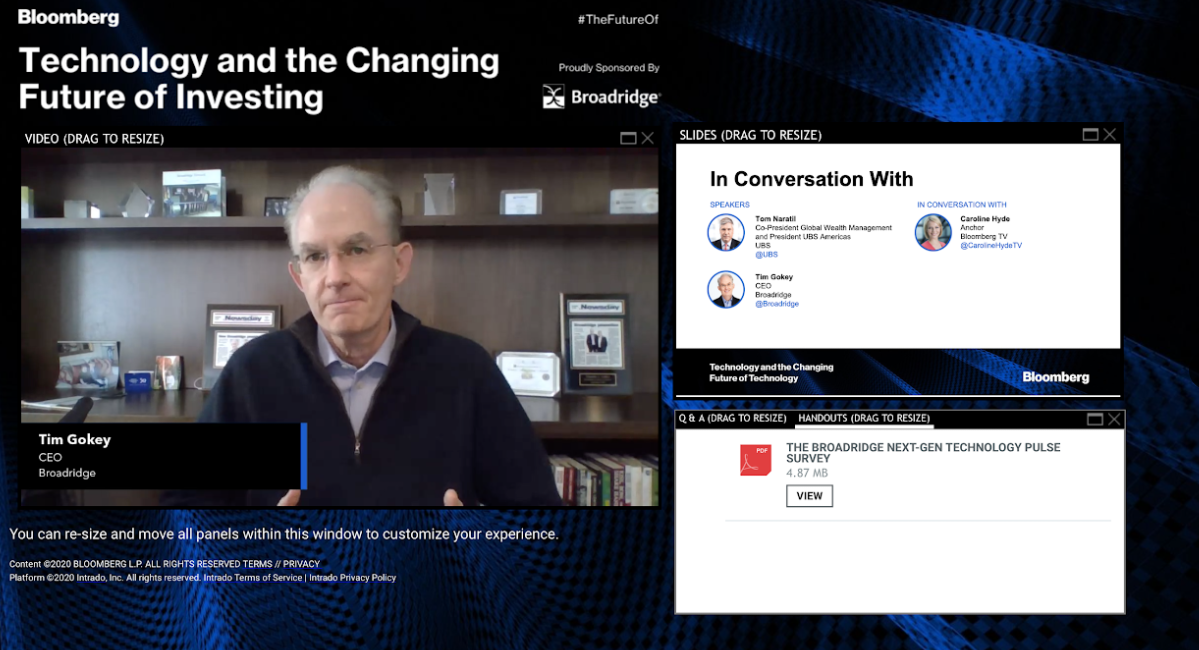
Event Highlights
Technology and the Changing Future of Investing
By Kiley Lambert, Bloomberg Live
As the pace of evolution in and around the financial markets accelerates, tools we use for investing have become increasingly complex and sophisticated. Overlapping and ongoing crises – from COVID-19 to global warming to social injustice – have increased uncertainty and disruption. Digitization and technological solutions have reduced costs and provided investors with greater access to the markets. They are no longer optional but necessary to survive and thrive in today’s climate. Technologies such as artificial intelligence, blockchain and cloud are being fast-tracked to provide much-needed solutions right now, not in some distant future. For financial leaders, these and other tools could make a significant difference in managing costs and risks and realizing their growth and return goals.
In this briefing, we talked to a range of market specialists and senior financial leaders about how technology is providing predictability, security and liquidity in a volatile world.
Speakers included:
- Horace Carter, EVP, Head of Fixed Income Capital Markets, Raymond James
- Nadine Chakar, EVP, Head of State Street Global Markets, State Street
- Tim Gokey, CEO, Broadridge
- Tom Naratil, Co-President Global Wealth Management and President UBS Americas, UBS
- Jim Toffey, President, LTX
Moderators included:
- Caroline Hyde, Anchor, Bloomberg Television
- Larry Tabb, Director, Market Structure Research, Bloomberg
Keep reading for more event highlights – and you can watch the full event here.
Tim Gokey, CEO, Broadridge, stressed that rather than forcing companies to create new models, the pandemic has actually accelerated changes that were already underway. “Prior to the pandemic, our clients were already seeing their business models needing to evolve, needing to change. And next generation technologies like AI, blockchain, cloud and digital, that we call the ABCDs, are part of that change. And post-pandemic, that is happening even faster. We see that in our client conversations. The biggest things we’re hearing are clients seeking next-generation mutualization, resiliency and digital transformation.”

Tom Naratil, Co-President Global Wealth Management and President UBS Americas, UBS, echoed Tim’s insights, adding that the digital tools are really just another way to engage clients in a more meaningful way. “Certainly, in a crisis like this in a wealth management business, there’s a desire on the part of our clients for engagement. They want the contact. They want to speak with their advisor more frequently than they have in the past. And they’re using new tools to be able to do that. So the advance that we’ve seen in terms of utilization of digital technology and the way that they engage with us, whether it’s engaging with their advisor in terms of a conversation, let’s say like this, over video. Whether it’s the way they engage with content like research. Whether it’s the way that they utilize digital tools to be able to handle some of the transactional activity that they have in terms of mobile check deposits and remote deposit capture, for example. All the utilization of those tools have spiked up during this crisis. We think that in a small short period of two to five months, we probably saw two to five years of increased technology adoption. And that puts us in a great place to be able to serve our clients even better going forward.”
On the application of next-generation technologies across the spectrum, Tim Gokey outlined specific areas where he sees significant advancements – fixed income markets and repurchase agreements:
“We’re very excited about…applying AI to fixed income. Liquidity and fixed income, it’s a huge issue. The number of CUSIPs is almost infinite and the future of fixed income trading is clearly using AI to find the natural common parties for a given trade and then to aggregate demand so that electronically, they can go beyond the small lot size. And broker dealers need to be in the center of that.”
“Another one, applying digital ledger technology to repurchase agreements. Repos are the cornerstone of how capital markets players finance themselves with literally trillions of dollars selling every day. And a lot of that activity is actually between entities within the same institution. And with DLT, securities can be mobilized to the custodian, tokenized and moved between entities with virtually no cost or risk.”
“When you think about the unique challenges faced by global institutions, typically the technology has developed by asset class, by region, leaving them with a very complex operating model, multiple books and records that creates additional risk, it traps capital. And so the idea of bringing that together in one global system, one global asset servicing platform that can really make a big difference for the global firms.”
On the future, Tim Gokey had this to say: “Near term, I think the impact of cloud is profound. And I’m not sure if that’s looking around the corner…but it’s much more than an infrastructure play. It’s about modernization. It’s about a whole core suite of software-based microservices, DevOps, with continuous deployment, improved security. It’s gone from clients asking for no cloud to cloud ready to only cloud. And this can be an area where leveraging the modern SaaS service can take some of that work away.”
Tim Gokey continued, “I think a little bit further [out]…AI will have tremendous impact. I think that every application will have AI embedded as a key enabler and to be ready for that, firms need clean, complete and open data. And I think in some sense, that’s where folks should focus today in order to be ready for tomorrow.”
Tom Naratil added, “So what we’re looking at, and this has been a significant focus of what Tim and I and the team have been focused on in terms of the development of the wealth management of America’s platform and the utility…has been, how do we get adoption? And we’re working with adult learning experts on how do we make relevant education? And I think probably the coolest thing we’re doing is what we’re calling the development of the sandbox, which is the pre-live version of the technology. So our advisors, our client service associates and our other team members are gonna be able to play around and not in the real world, be able to make mistakes, [and] learn from making those mistakes. So I think this, the focus on how [to] utilize learning and a fun way to learn is going to be critical to the technology adoption.”

On the topic of technological advancements in the fixed-income markets, Horace Carter, EVP, Head of Fixed Income Capital Markets from Raymond James, outlined the changes that have taken place over the last ten years, but also how far there is still to go to making the markets as efficient as they could be. One of the key challenges in the markets today, he said, was “wasted energy…We’re spending a lot of time and a lot of resources on price discovery. In March, for example, the number of inquiries that we had approximately tripled and the conversion rate dropped to about 20%. So that’s one of the big challenges. Other than the obvious challenge of having difficulty finding attractive yields for our investors right now.”
Nadine Chakar, EVP, Head of State Street Global Markets, State Street, added that the buy-side is struggling to streamline automation. “So what we’re seeing is still a lot of buy-side firms operating on legacy infrastructure. And if you think through what Horace said, the ability to aggregate data, map it, reconciling it, then do your modeling and trade, requires robust data strategies, and computing power, that not all firms have.
It’s not lost on us that we’re seeing a proliferation of electronic trading venues but yet still a very low percentage of bond trading done electronically.”

Despite the relatively analog nature of bond trading, Jim Toffey, President, LTX sees big changes in the markets in the near future. “The space has changed a lot in the last 20 years. I mean, RFQ…was an important protocol, and really kind of took the bond markets forward. But really, if you look at RFQ, it’s a protocol designed to electronify the phone call from before. And even though RFQ is very widely used, when you look at aggregate numbers like in the corporate bond market, over 70% of the market is still done, not electronically, but over the phone or over IM or something like that. So there’s still a long ways to go.”
Jim Toffey continued, “And I think what you’re gonna see here over the next several years is an advancement on two levels. One using AI and machine learning to make people smarter around the data of, for example, when is the right time to trade? Where’s the most liquidity? Who are the natural buyers and sellers that should be invited to that trade? So I think there’s gonna be a lot of emphasis on using data to help both the buy-side and the sell-side trade smarter. And then on the trading protocol side, I think you’re about to see, and this is one of the things we’re working on at LTX at Broadridge, which is the next level, the next generation of protocols that will go beyond RFQ, that will aggregate liquidity, that will create better price improvement in kind of the old RFQ model.”
——————————
Join the Conversation: #TheFutureOf
Instagram: @BloombergLive
LinkedIn: Bloomberg Live
Twitter: @BloombergLive
Interested in more Bloomberg Live virtual events? Sign up here to get alerts.
——————————
